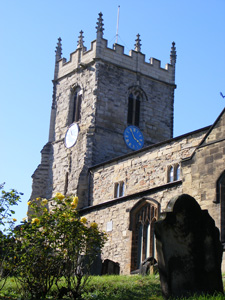
 |
No-one knows for sure how old Stranton Church is. The central part of the present building dates back to around the twelfth century. It is highly likely that there was a previous building on the site, and a recent archaeological survey concluded that large stones in the wall of the nave are Saxon in origin. In medieval times, the historic parish of Stranton covered almost the whole of what is now Hartlepool, except for the old town of Hartlepool on the headland (St Hilda’s parish) and the village of Hart to the north-west. The church stands on this ancient site on a hill easily seen by anyone traveling north into Hartlepool on the A689. Stranton (‘the town on the shore’) was the old Saxon village where, until the mid nineteenth century, white-washed cottages surrounded a green. There was a pond, a vicarage, and mill with the church on the hill. The sea – much nearer in those days - washed the shore to the east. Robert de Brus granted Stranton's patronage to Gisborough Priory about 1120. The vicarage was ordained before 1234 and Stranton appropriated the Priory. This meant the tithes [or income] went to them. After the Dissolution of the Monasteries, in 1536, Henry VIII took over the patronage for the crown which it retained until 1607 [James 1] when Philip Chewte and Richard Moors were granted the Rectory. Later still it became the gift of the White Ridleys, then Mr. Tom Robinson. It is now in the gift of St. John's College, Durham. There is a vicars' board on the north wall of the nave. The first name on the list is Richard de Topcliffe, 1312, but there were others before him whose names are not recorded. The present incumbent is the Rev John Bell, who arrived in 2022. Like many English churches Stranton is a mixture of styles and stonework. Apart from the Saxon stonework in the nave, the oldest part of the building is the twelfth-century semicircular arch in the east wall behind the Communion table. About 1280, a north aisle was added; the tower arch and a north arcade were built. Then in the fourteenth century, the chancel was reconstructed, the south aisle added, the tower remodeled and the upper part built. In the fifteenth century, a chapel, now called the Fulthorpe Chapel, was added to the north side of the chancel. The whole north wall of the chancel was taken down and two arches inserted. At the same time a new chancel arch was added and the clerestory and the porch were built. The next transformation took place in the eighteenth century. A gallery was put above the north aisle and the nave was completely altered on that side. The north clerestory was removed, the aisle wall raised and a new roof of a flatter pitch put over the nave on the north side. The south clerestory was left as it was. The Fulthorpe Chapel roof was altered in pitch and the side walls raised. The chapel was converted into a school which meant resulted in the arches being bricked up. The walls and stonework were whitewashed and the paintings, which used to adorn the walls, were covered over. In Victorian times, two vestries were added to the north side of the building: one is now the choir vestry and the other the kitchen. The organ chamber was also built to house the fine Abbott and Smith organ (1889). The building has continued to develop in recent years. In the 1980s, the Fulthorpe Chapel was screened off from the chancel and has become a place for Childrens club, Youth Fellowship and small group meetings. Under the tower gallery (installed in the 1990's) there is now an accessible toilet and refreshments servery and the Vestry is located in the North-western offshoot where it now doubles as a creche – all reflecting the way this ancient building continues to evolve to meet new needs. Audiovisual systems installed in 2022 are in discreet sympathy with the historic nature of the building. The eight Tower Bells were re-tuned and re-hung in 2023, markedly increasing the appeal and presence of the building in the locality. |
The Organ |
|---|---|---|
| History and information about the organ | ||
| The Bells | ||
| History and information about the church bells |